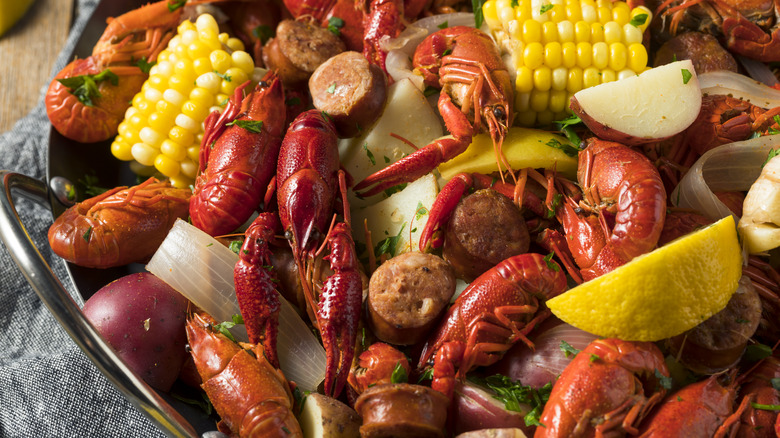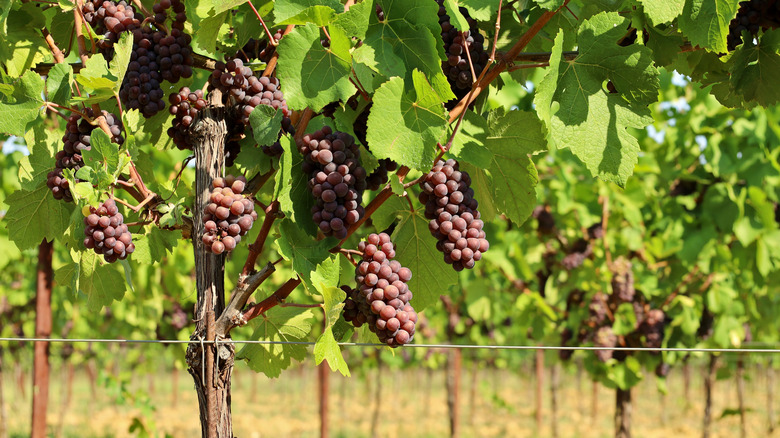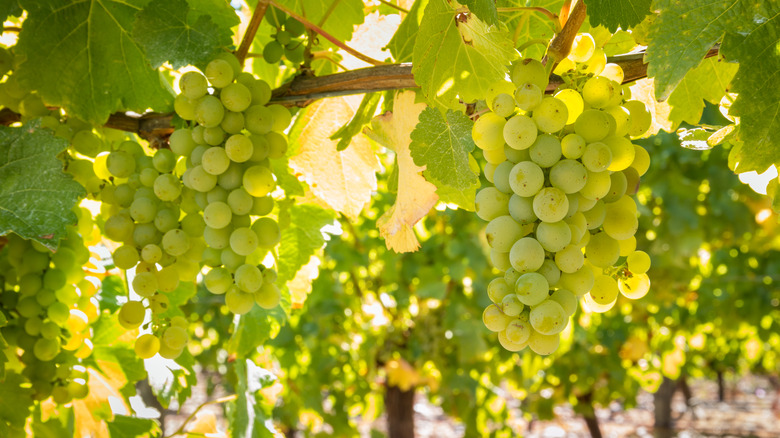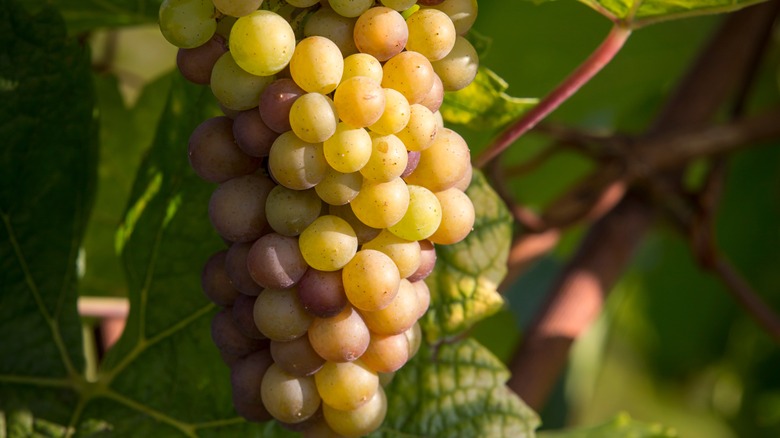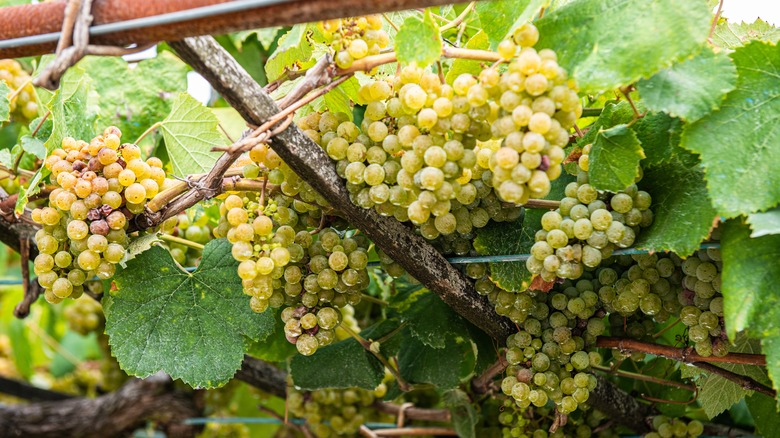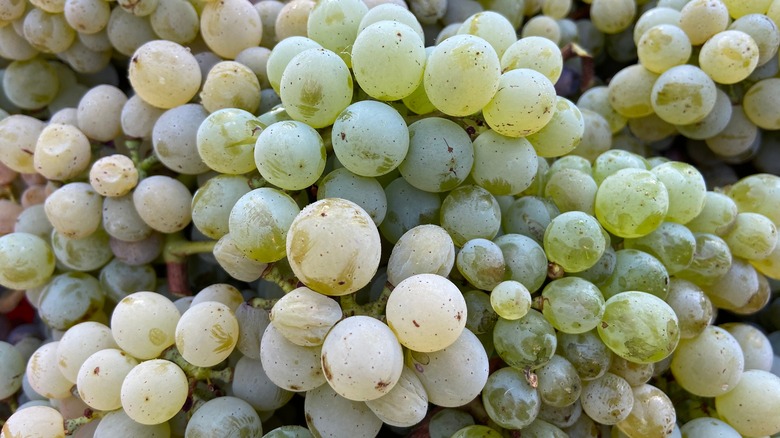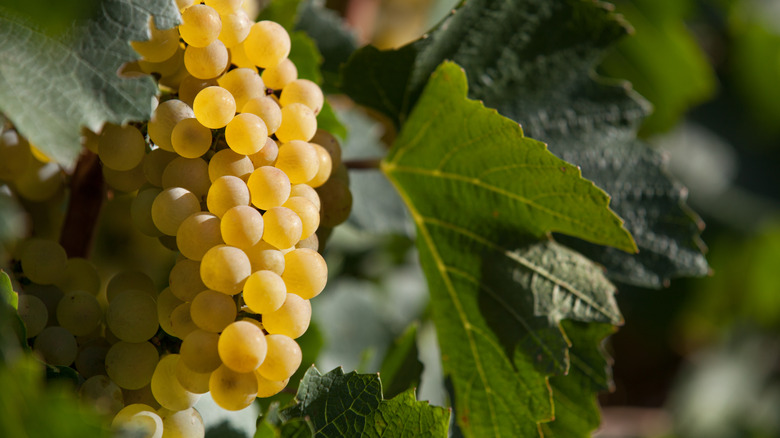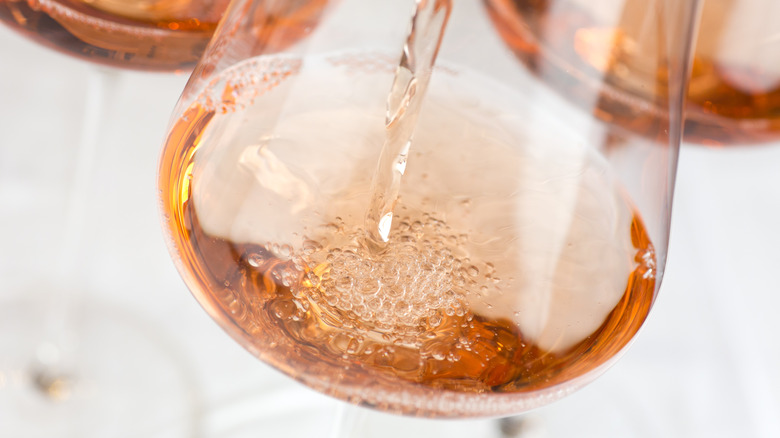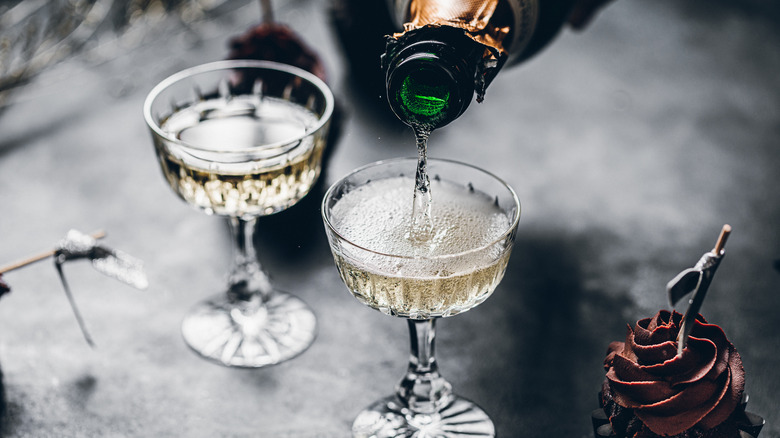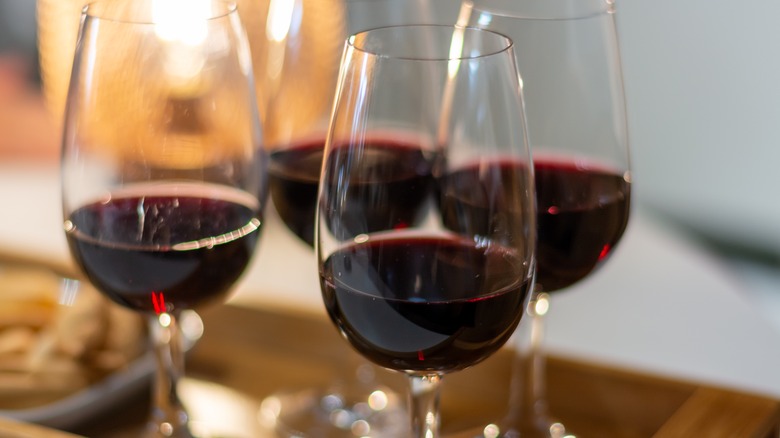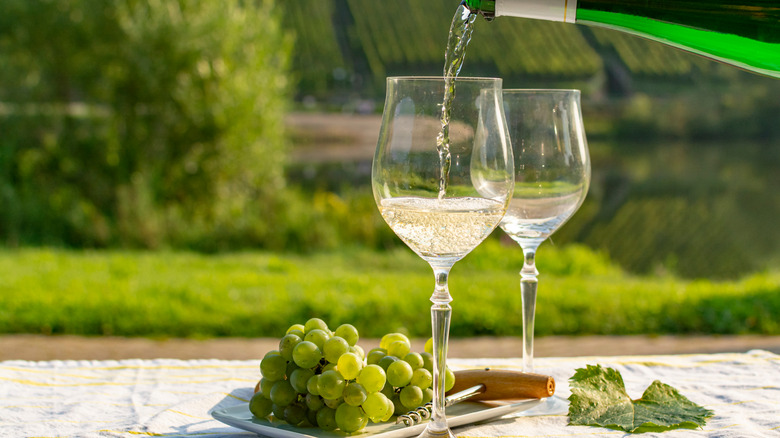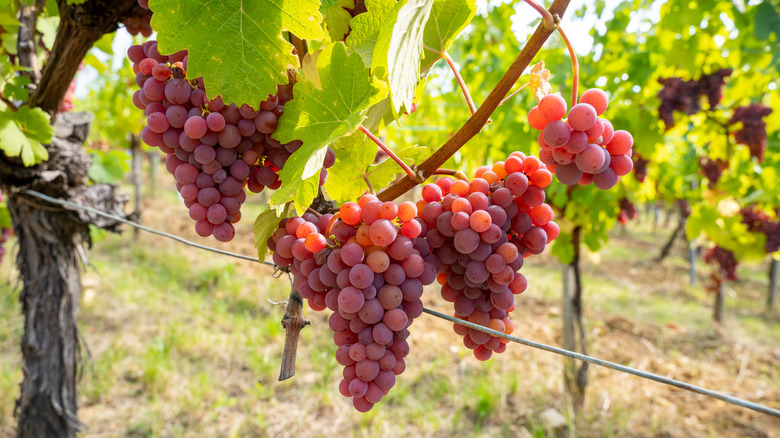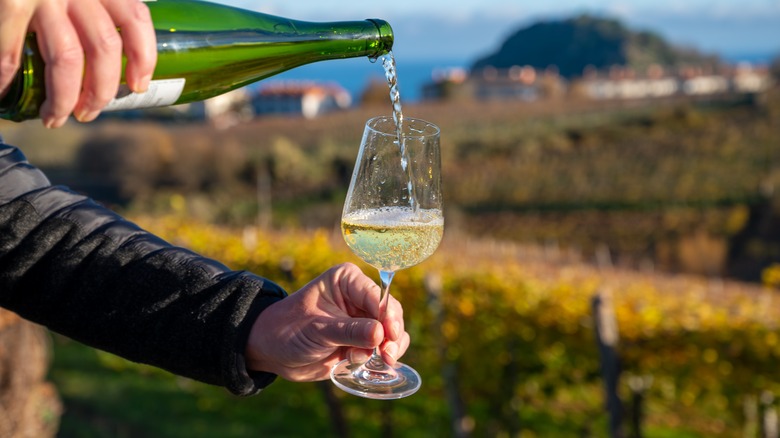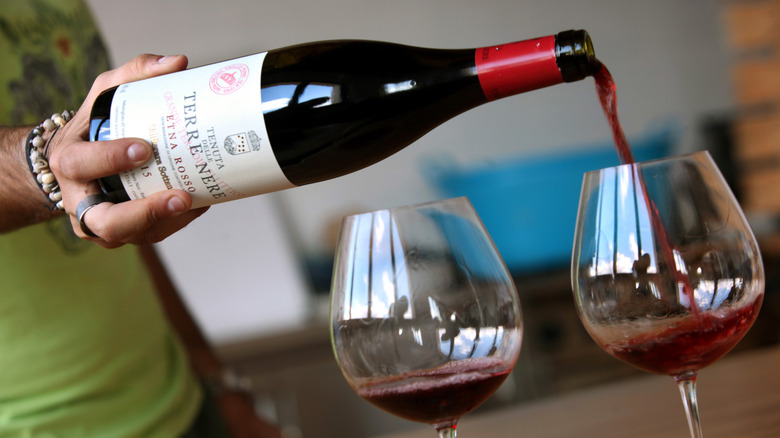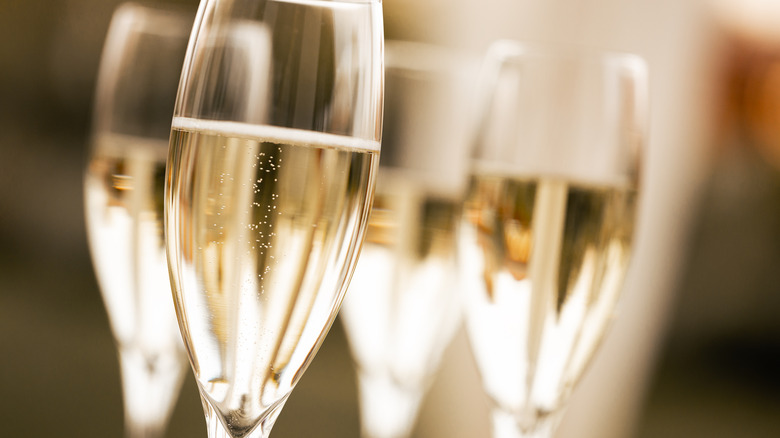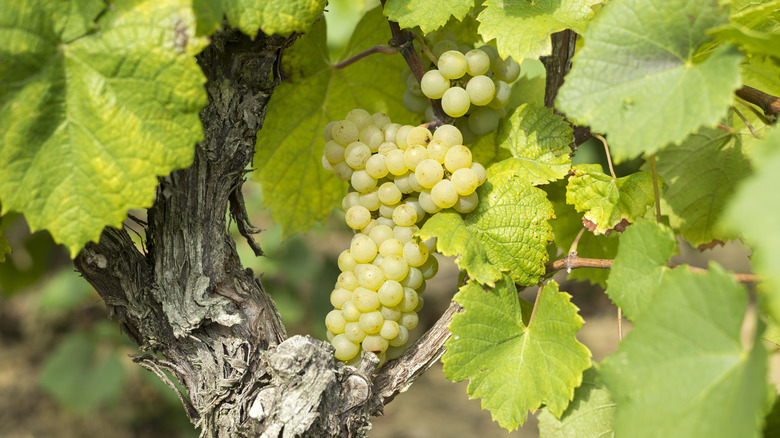15 Best Wines To Pair With Your Next Seafood Boil
There are countless ways to eat seafood, but the most festive may be a seafood boil. Whether you prefer a Louisiana, low-country, Chesapeake Bay, or a New England-style boil, it's all about the same thing: getting together with friends and family to enjoy an interactive (and delicious) way of eating. Some types of seafood boils tend toward the spicy end of the spectrum, while others are milder. Some utilize crawfish or shrimp, and others prize lobsters and clams. Whatever style of seafood boil you're planning, there's one question you'll eventually ask yourself: What are we going to drink?
In some cases, beer may seem like the obvious beverage pairing for a seafood boil. But true seafood lovers know that wine is a good option too. From light and fresh white wines that pair well with milder types of seafood to savory reds that pair well with bold Cajun flavors, there are a wide variety of wines that work well with seafood boils. Ready to take your next seafood boil to the next level? Check out these 15 wines to enjoy with boiled lobster, clams, crawfish, and more.
Pinot grigio
When you want a wine that's simple, fresh, and easily drinkable to pair with your seafood boil, you may want to opt for a pinot grigio. This light-bodied wine is perfect for seafood boils because of its refreshing acidity, which makes your mouth water and prepares you to take another bite of shellfish, corn, or potatoes. Pinot grigio also tends to have a refreshing minerality, which plays well with the natural saltiness of the seafood. You may notice notes of green apple and pear in a pinot grigio, which offer a light flavor profile that's hard not to enjoy.
Pinot grigio hails from Italy, where it tends to be refreshing, and acidic. You may also find a bitter almond note. If you're searching for an Italian pinot grigio, look for producers from Friuli and Alto Adige, which are known as some of the best white wine-growing regions in the country. However, it's also possible to find American pinot grigio, which tends to have less acidity and more fruit flavors than its Italian cousin. Since pinot grigio is such a classic pairing with seafood, a great bottle will undoubtedly enhance your seafood boil.
Sauvignon blanc
Looking for an easy pairing that's guaranteed to please pretty much everyone around the table? In that case, turn to a sauvignon blanc, which is among the most popular seafood-pairing wines. Like pinot grigio, sauvignon blanc is very light-bodied, meaning that it won't weigh down your palate. But don't think that means you're getting a wine without flavor — the best sauvignon blancs pack a concentrated flavor profile that can pop against the seafood flavors from the boil. You might notice bright citrus flavors with lots of acidity along with a green, herbaceous note that works especially well with the savory flavors of a good seafood boil.
The best sauvignon blancs are grown in cool climates all over the world, but perhaps the most popular styles hail from France and New Zealand. The most famous French sauvignon blancs call the Loire Valley home, and in this northern region of the country, winemakers focus on fresh fruit flavors. The result is a complex, balanced wine that works beautifully for seafood and a variety of other light dishes. New Zealand, on the other hand, is known for producing greener, more citrus-focused sauvignon blancs.
Pinot gris
Does pinot gris sound familiar? That's probably because it sounds similar to pinot grigio, which is mentioned above. Turns out, pinot gris and pinot grigio are actually the same grape. However, "pinot gris" is used to refer to the French style of the wine, while "pinot grigio" is used for the Italian style. While pinot grigio tends to be very light-bodied, pinot gris might have some more weight to it. It may have more intense fruit flavors, lower acidity, and higher alcohol levels than its Italian counterpart. This makes it a great choice for pairing with a seafood boil that's very seasoned and flavorful because it provides a richer, more concentrated flavor to contrast the flavors of the seafood boil.
Wondering what regions you should be looking into if you're craving a pinot gris to pair with your seafood boil? Some of the best-known pinot gris comes from Alsace, France, which tends to produce quite full-bodied expressions of the grape. Oregon, in the United States, is also known for producing pinot gris, albeit often with less acidity than French expressions of the grape.
Albarino
Albarino is grown in the Iberian Peninsula, which contains both Spain and Portugal, and it's known for its high acidity, stone fruit flavors, and pronounced salinity, or saltiness, which makes it an ideal pairing for your next seafood boil. Most wines made from the albarino grape are going to be unoaked, which means they retain their fresh fruit flavors that come from the fruit itself. However, these days, some albarino producers are using oak, which imparts a vanilla or coconut flavor, or lees contact, which gives a wine a bread-y, brioche-y quality.
Seafood and albarino are a classic combination that almost always works well. The fresh, usually uncomplicated flavors of good albarino won't clash with the light flavors of lobster and other types of seafood, although a concentrated albarino can certainly stand up to a spicy seafood boil. Check out albarinos from Spain's Rías Baixas or Portugal's Vinho Verde for some of the best examples.
Chenin blanc
Want to try something a little different at your next seafood boil? It may be time to turn to a chenin blanc, which can come in a wide variety of styles. Whether you want a crisp dry wine, a refreshing sparkler, or something with a little bit of sugar on it, chenin is the pick. Chenin is known for being a very acidic wine, which makes it quite food-friendly, but it tends to have more body than some of its other white wine grape counterparts. Expect to find notes of green apple, honey, pineapple, and even orange peel.
If you're the kind of person who prefers their seafood boils hot and spicy, you're in luck — chenin, particularly a demi-sec (or semi-sweet) chenin, can work especially well with spicy seafood dishes because they're light enough not to overpower the seafood but flavorful enough to compete wash with those spicy flavors. You can find quality chenin blanc from France's Loire Valley as well as in South Africa, where it's frequently referred to as "steen."
Chardonnay
Just because you're eating seafood doesn't mean that you have to opt for a light-bodied white wine. If you want something that usually has a bit more body to it, go for a chardonnay. This is one of the most popular grapes in the world, and it comes in a variety of styles — in fact, it's one of the most versatile wine grapes. Lighter, more refreshing chardonnays tend to be unoaked, which means they display fresher fruit aromas like lemon, apple, and pineapple. These types of chardonnays are your best bet when pairing with seafood, as their bright acidity is a nice match for a seafood boil. On the other hand, fuller-bodied, more oaky chardonnays may overpower the flavor of seafood.
Look for cooler climate chardonnays if you want that bright, fresh flavor. Some of the best examples come from Chablis, in France. Chablis is situated in northern Burgundy, the traditional home of chardonnay. These wines are lean and steely with notes of green apple and citrus, and they pair beautifully with seafood.
Dry rosé
You may assume that you have to opt for a white wine if you're preparing a seafood boil, but that's far from the case. If you're looking for an alternative option that's on the lighter, more refreshing side, consider selecting a dry rosé. Many types of rosé are quite versatile, meaning they go with a wide variety of dishes — seafood boils included. These wines will often have high levels of acidity, which is great for pairing with food, along with fruity flavors that provide a contrast to the savory notes of the seafood boil. Plus, rosé tends to be popular, so it's a wine that's a safe bet even for your non-wine-drinking friends.
If you're searching for a crisp, dry rosé, consider wines from the Provence region of France, where some of the most well-known rosé in the world comes from. Similarly, it's often possible to find Greek rosé wines that are similarly refreshing and perfect for pairing with a seafood boil.
Crémant
If you love sparkling wine but don't always adore the prices that Champagne commands, then you may want to consider pairing some crémant with your next seafood boil. Crémant is not a grape but a style of wine — essentially, it's a sparkling wine made with the same production method as Champagne but produced outside of the Champagne region of France. This method is known as the "traditional method," and it involves two separate fermentations before it reaches its bubbly state. Some of the best examples come from the French regions of Alsace, Burgundy, the Loire, and Limoux, among others.
Traditional method sparkling wines are known for their ability to pair well with seafood, and crémant is no exception. It's particularly delicious with shellfish-based seafood boils, so if you're making clams or mussels, it's a must-try pairing. The bubbles in this wine make it refreshing and easy to drink, so you can enjoy a glass or two (or three) while enjoying your seafood boil, regardless of the style you're opting for.
Rioja
Most of the wines on this list are white, but don't feel like you have to limit yourself just because you're eating seafood. In some cases, red wines can pair beautifully with seafood — especially when you're making a deeply flavorful seafood boil. One great example? Red Rioja wine. Red Rioja, made in the Rioja region of Spain, is produced from tempranillo grapes, which have a notoriously savory characteristic. Notes of dill and other herbs are common, and it's this herbaceous note that makes red Rioja such a beautiful pairing for a seafood boil.
However, you'll want to think about the style of seafood boil you're going for when you choose your wine. A seafood boil that's lighter in flavor may not be able to compete with the intense flavors of this wine. Rather, you're better off pairing red Rioja with a Louisiana-style seafood boil, with its bold, spicy flavors that can stand up well to red wine.
Riesling
Intensely aromatic and made in a wide variety of styles, it could be argued that riesling can be paired with just about anything. It's a wine that tends to goes well with iodine notes, which are found in shellfish and seafood, making it an ideal pairing for your next seafood boil. In the glass, you'll notice aromas of stone fruits and apple and maybe even floral notes like jasmine. But riesling is perhaps best known for its aroma of petrol, or gasoline (which may sound unpleasant but is actually quite lovely when it's balanced). Its high acidity makes it a food-friendly wine that will pair wonderfully with crab, shrimp, crawfish, and beyond. Particularly good rieslings hail from Germany (especially the Mosel), Alsace in France, and the Finger Lakes in upstate New York.
If you're making a spicy seafood boil, look for a riesling with a lower alcohol content, as higher-alcohol wines can increase the intensity of that heat. These lower-alcohol rieslings are often either slightly sweet or sweet in general, which go well with spicy dishes because they tend to mellow out those fiery flavors.
Gewurztraminer
Gewurztraminer may not be the most common grape on your local wine store's shelves, but that doesn't mean it's not worth seeking out if you're looking for something different for your seafood boil. It's known for its floral and tropical fruit notes, and on the nose, it smells like it would be quite sweet. Some gewurztraminers are sweet, but other varieties are dry, despite their intensely aromatic nature. It's sometimes described as having an oily or viscous texture, which can be a nice departure from otherwise light-bodied wines.
This kind of wine may not be ideal for all types of seafood boils — the intense flavors of the wine can clash with lighter styles of the dish. Therefore, you're best off choosing a gewurztraminer for a seafood boil that features plenty of herbs and spices so the wine doesn't drown out those more subtle flavors. And if you're trying to make the spice level of your seafood boil less intense, consider choosing a sweet gewurztraminer. Some of the best examples come from Alsace, France, and Alto Adige, Italy.
Txakoli
Spritzy, dry, and refreshing, it's hard not to love txakoli, a wine made from the Hondurrabi Zuri grape, produced in Spain's Basque country. On the palate, you'll find notes of lime, unripe red fruits, and dried herbs, but this wine is also known for its signature salinity, which pairs nicely with a seafood boil. In fact, txakoli is a particularly popular wine for pairing with seafood, as that salinity and its racy acidity create a classic cleansing effect with a variety of seafood dishes, including from the spice of a boil.
Because of its light and refreshing nature, it's made for seafood, and it can work well with both spicy and milder boils. And since it's only slightly carbonated, it's a great sparkling option for those who love bubbly but who don't want all those bubbles to take up too much room in their stomachs — you'll want to be able to get your fill of crawfish, lobsters, clams, potatoes, and corn before you tap out.
Etna rosso
Searching for another red wine option for your seafood boil? Look no further than Etna rosso. This Italian wine is ideal for people who aren't fans of white but still want something refreshing and satisfying to sip on during their seafood boil meal. Etna rosso is primarily made from the grape nerello mascalese, which has a light body and is often compared to pinot noir (but generally at a lower price point). On the tongue, you may first notice bright red fruit flavors, but there's also an herbaceous, savory quality there that pairs well with the salty flavors you'll find in a seafood boil.
Some find that Etna rosso has a peppery quality to it, which makes it an especially delicious pairing for a seafood boil. It's light enough that it's refreshing, but it's complex and richly textured enough to stand up to flavors of cayenne and dried herbs that are often found in seafood boil spice mixtures.
Champagne
Dry Champagne and seafood are a match made in heaven. It's one of the most classic pairings, and it makes sense: light, refreshing bubbles just taste delicious when paired with the light, fresh flavors of good-quality seafood. Like other traditional method sparkling wines, Champagne is usually highly acidic, with notes of green apple and citrus. There's also a creamy, bready quality in many of the best Champagnes, a flavor profile that comes from extensive lees aging.
Can Champagne be expensive? Of course. But if you're willing to spend some extra cash, you shouldn't let the price point stop you from pairing Champagne with a seafood boil. Not only do the flavors work well together, but it's also a fun high-low combination that brings fun to your seafood boil. You can always choose a Champagne from a well-known brand, but some of the best expressions of the wine are known as "grower Champagnes," and they come from small producers. Ask your local wine shop rep to help you locate a Champagne that will work well with your seafood boil menu.
Muscadet
Another wine from the Loire Valley that you may want to pair with your next seafood boil is muscadet. This wine is made from melon de bourgogne grapes, which create a wine that has high acidity and a minerally, citrusy quality to it. These salty, bright flavors work well with seafood of all types — in fact, muscadet is perhaps one of the most celebrated pairings for seafood — including seafood boils. Unlike some of their white wine counterparts, muscadet wines don't tend to be too fruity. Instead, they're usually lean and have a greenness to them — ideal for pairing with the savory flavors of a good seafood boil. Muscadet and shellfish is a common pairing, so don't go light on the clams, crawfish, crabs, and more.
Ask your local wine store rep about the muscadets they have if you're looking for a particular flavor. Muscadets that have been aged on the lees will have a richer body and more yeasty flavor, while those with less lees-aging will taste lighter and fresher on average.
